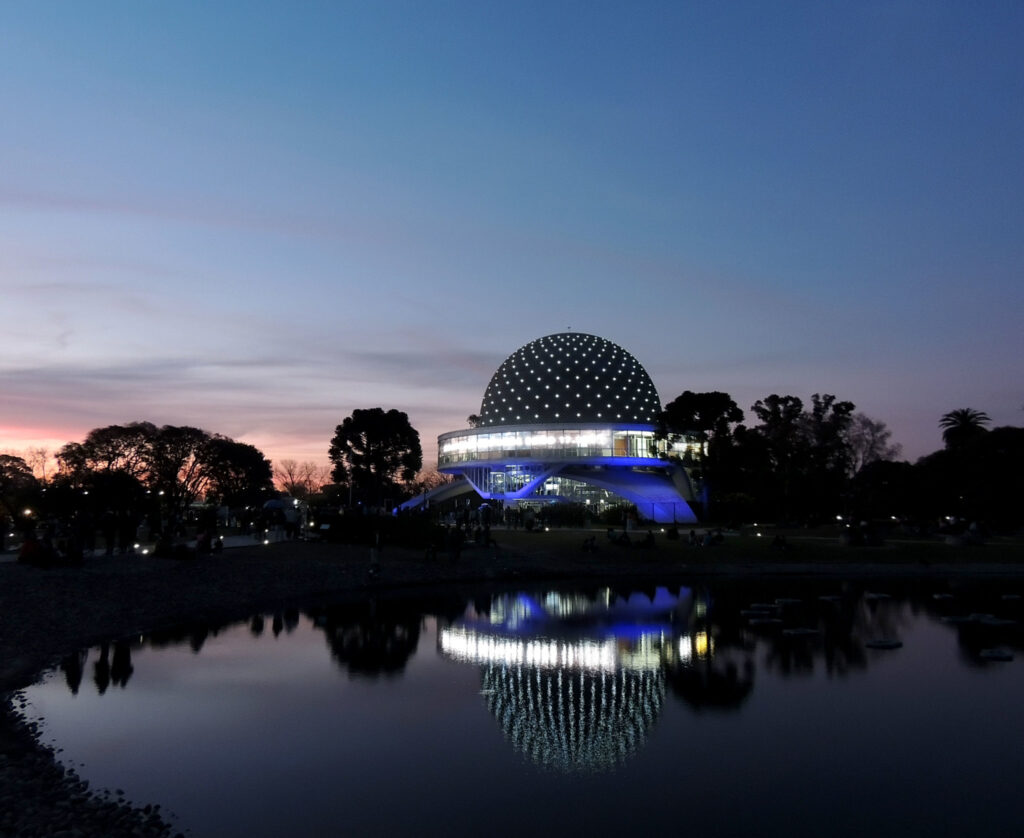The Galileo Galilei Planetarium is one of the most important tourist attractions in Buenos Aires. For some it is a must-see, guided by curiosity about its structure and its projections, while for others it is a place where they can find information about astronomy, the universe and outer space.
For both children and adults, the Galileo Galilei Planetarium in Buenos Aires offers endless activities. In addition, the entrance is very affordable and you will be amazed by its five floors and its imposing dome.
In this brief guide we invite you to learn more about the Galileo Galilei Planetarium so you can add it to your list of activities for your next trip through the Palermo neighborhood in Buenos Aires.
Galileo Galilei Planetarium (Buenos Aires): Everything You Need to Know Before Your Visit
What is the Galileo Galilei Planetarium?
The Galileo Galilei Planetarium is the main center for astronomy education in Buenos Aires. Located in the Palermo neighborhood, it has been a fascinating attraction for both locals and tourists for decades, especially those curious about the cosmos.
The planetarium features a semi-spherical projection room with 360 reclining seats and a 20-meter-diameter dome. This dome displays approximately 8,900 stars, planets, and satellites from the universe, thanks to an impressive setup that includes six Sky-Skan projectors with 8K resolution, translating to 38 million pixels.
The five-story building also houses a museum, a secondary projection room, and a collection of meteorites from northern Argentina. Since its opening in 1967, the planetarium has undergone several renovations, with significant updates in 2011 and 2017, to incorporate the latest technology.
The planetarium’s structure includes a 20-meter diameter dome that can display 8,900 fixed stars, constellations, and nebulas. In addition to its five floors, the building has six staircases and an exterior dome that is 8 centimeters thick, with a radius of 11.5 meters and a cover made of 960 individual prefabricated panels.

Where is the Galileo Galilei Planetarium?
The Galileo Galilei Planetarium is situated in Dr. Benjamín A. Gould Plaza in the Palermo neighborhood, right on Sarmiento Avenue. This plaza, along with nearby green spaces, is part of the Parque 3 de Febrero, one of the largest parks in Buenos Aires.
The area is a popular spot for locals to enjoy outdoor activities, such as biking, running, exercising, and even relaxing by the park’s lakes. Nearby attractions include the Japanese Garden to the southeast and, further south along Sarmiento Avenue, the Buenos Aires Eco Park and Botanical Garden.
To the north of the planetarium is the Jorge Newbery Airport and Costanera Norte Avenue, a favorite among locals for its stunning views of the Río de la Plata.
The Palermo neighborhood extends to the south and west of the planetarium, reaching the borders of Almagro and Belgrano, while it borders Recoleta to the east and, beyond that, the Retiro neighborhood.
How to Get to the Galileo Galilei Planetarium?
The Galileo Galilei Planetarium is one of the most visited spots in Buenos Aires, attracting both locals and tourists daily. However, getting there can be a bit tricky due to the area’s expansive green spaces and limited public transport options.
Unlike other tourist attractions in Buenos Aires, the subway is not an option for reaching the planetarium.
The best way to get there is by bus, with several lines running along Sarmiento Avenue, Presidente Figueroa Alcorta Avenue, and, a bit further away, Libertador Avenue. Some of the bus lines you can take include 37, 67, 102, 130, and 160.
The area is also ideal for cycling, with protected bike lanes and exclusive paths along Sarmiento Avenue, Pres. Figueroa Alcorta Avenue, and Belisario Roldan Avenue. However, if you’re driving, you’ll need to find a private parking spot, with the nearest ones located beyond Libertador Avenue.
Why Visit the Galileo Galilei Planetarium?
Shows for the General Public
The Galileo Galilei Planetarium offers a variety of shows for the general public, which are updated each season. Some of these shows are designed for children, while others are tailored for teenagers and adults.
Museum
The planetarium also features a museum, and its surrounding plaza offers representations of the Earth and the celestial sphere, real meteorites, lunar rocks, and other attractions that provide a unique perspective on our planet and the universe.
Astronomy Courses
For those interested in astronomy, the planetarium offers courses on topics such as the universe, cosmic structures, astrophysics, and more. These classes are free and open to the public, although some are specifically aimed at teenagers or adults.
Telescopes
On Saturdays and Sundays at dusk, the Galileo Galilei Planetarium allows visitors to observe the night sky through its telescopes. This activity is free and operates on a first-come, first-served basis, with a capacity of 250 people. However, the activity may be canceled in case of rain or heavy cloud cover, as these conditions would make observation difficult.
(Featured Image Source: MMC/manelo/flickr.com)


